December 15, 2017
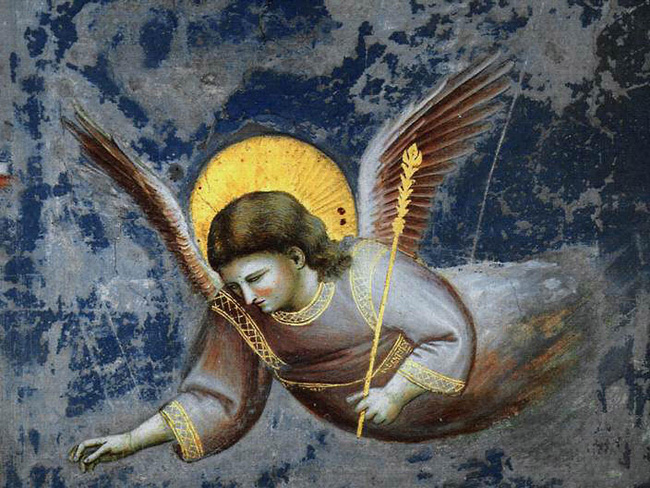
Giotto. Angel of Annunciation. 14th C. Padua
This morning when I drew my curtains aside to look at the oceanfront, the mountains and the island across the way had disappeared beneath the white of snow and clouds. What came to mind was the trek the Blessed Mother and Joseph made eons ago.

Giotto. Holy Family, Flight to Egypt, 14th Century
I imagine the holy trio traversing hill and dale. Mary riding side-saddle on a mule, carrying the weight of her newborn son, clutching him lovingly to her breast. Joseph on foot, a large bundle strapped to his back, the man leading the way from Bethlehem to Egypt.
I try to imagine the rations, the number of coverlets, cups, pots, spoons, the shape and length of the knife Joseph hid beneath his cloak— if he carried one at all. My thoughts turn to Mary as I wonder what she packed and what she left behind. Should she forsake Anne’s pendant for the bag of dried figs, or dispense with the second pair of sandals?
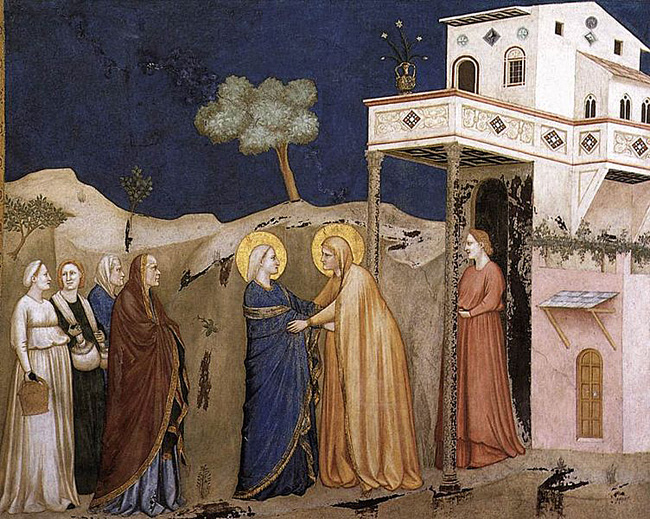
Giotto. The Visitation, 14th Century
In Mary and Joseph’s case, treks like theirs meant you didn’t know who friend or foe might be on the road. So, if you wanted to make it home and back again, packing the essentials for the task at hand meant sacrifices; leaving behind certain things that were once dear.
These days, what takes us an hour to get to by car, might have taken Mary and Joseph days by mule. Still no matter how long the journey, a cross country trek requires vision, forethought, foresight, some planning and preparation to get there. Luckily for the 3 Magi, a star appeared to guide and light their way towards the Blessed Mother and her baby boy.

Giotto. Adoration of the Magi. 14th Century
Like the Magi, my husband and I may see a star in the Irish skies during Advent, yet this Christmas along with the New Year will find us skyscraper-deep in packing boxes. You see we’re on the move again. Our landlord wants to sell the house we’re presently renting. For months now we’ve been on the search for a new place and finally hit on one that’s roomier, not too far from town, and suits our budget. Now you know what has kept me busy for the past few months, and why I haven’t been so prolific.
Last year I introduced my readers to SoulCollage® and the making of the Daughters of Mother Christmas and the Sons of Father Christmas cards. If you’re new to SoulCollage® you can learn about the process and follow the directions under SoulCollage® on this site, and/or visit www.soulcollage.com for more information.

I. Ebaen. Daughters of Mother Christmas, from SoulCollage series, 2016
Not to disappoint but I’ve got to get back to my packing, yet I’m itching to put my expression on paper and create. This year I want to honour the presence and the nurturing I continuously receive from the Blessed Mother. Also, I want to share my gratitude for a place called home. Thirdly, I aim to compose an image that speaks to me of the season: the quality of its light, its shadow, its earthiness. I yearn for the stillness, for the black and whiteness of the artwork to draw me inwards, towards my centre, so that I may gaze upon it and regenerate and refuel. A triptych is the way to go. Inspired to discover, I begin the journey sensing what wants to be expressed.

Jacobello del Fiore. Triptych
For the front of my triptych I’ve chosen to create 3 photo-montage- images and 3 others on the backside. I’m using the adobe elements program to montage my photos on my computer.

In Honour of the Blessed Mother

Winter Solstice

Gratitude for a Place Called Home
Using duo matt 340 micron professional inkjet photo paper, I print 3 images on the front side, and 3 images on the reverse side (make sure images are aligned so that they print accordingly.
Having finished composing the photo-montages and the printing, I see I have two pages to laminate; so I use 2 (100 micron) clear laminating sheets.
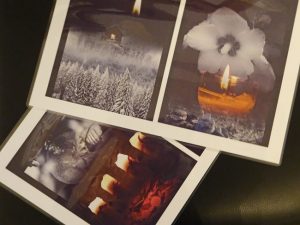
photo-montages laminated .

backside view of laminated sheet
I slip a photo-montaged page between one of the laminating sheets, and carefully feed it through the laminator (read your laminator instructions for use). I do the same with the second photo-montaged page, and laminate through the machine.
Leave the laminated pages air cool before attempting to cut.
Once sheets have cooled, carefully cut the excess lamination with a pair of sharp metal scissors.
Lay the panels on a flat surface and consider how you’ll attach the 3. Should you punch holes? Sew them? Tack, tie, or tape the panels to achieve a tri-fold effect?

using a hole punch
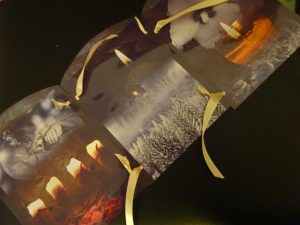
layout of panels
Be patient and gentle with yourself. Take your time making decisions so that the outcome pleases the senses. There’s nothing wrong with creating an aesthetic piece. Forget what others may think. The only limitations are those you impose on yourself.
When you consider your work, if you feel something is off or needs changing, do it. Change it. Rearrange it. Remain alert. Flexible to change. Connect with your investigative, curious-self, and persevere. This way you and your attention are present with the process, with the art-making that engages and immerses you totally. Trust that your intuitive self knows exactly what it wants and how non-verbal expression needs to be seen.
You might consider creating your version of a Winter Solstice. Maybe you’ll cut, copy, collage, or draw a traditional icon, or birth it using modern, contemporary, or abstract images.
Perhaps include your favorite poem, essay, quote, flash-fiction story, prayer or psalm. Write it on the back of each image so that when you look at your triptych from behind, the words evoke a sense of stillness, contemplation, a quiet ease.

Plotinus, Greek Philosopher. A Message of Light
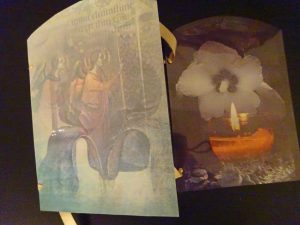
Flipside of Panel
Imagine how you would feel if you understood that the images mean to empower and encourage you to explore, create, invent, and possibly surprise?
Remember this is your triptych. If you can, allow yourself to think outside the box you know. Explore. Play. Have fun. No one is watching. You make the rules.
Use images that attract your attention, resonate with your needs, actually mean something dear to you. Imagine the images nourish your sensibilities opening your heart to the creator/artist longing for the freedom to be heard and express itself.
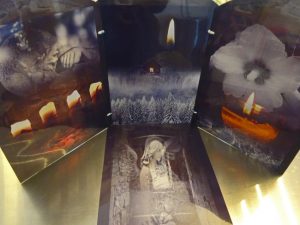
3 Panels
See what happens when you embellish, embellish, and embellish some more. Use glitter, sparkles, sequins, and pearls. Make a personal statement: a creation of contemplation to be placed on your mantle or bookshelf—and if you wish—for friends and relatives to see, feel and partake in your joy.
Conjure a triptych worthy of your worship, worthy of affection, worthy of your undivided attention and time.
Honour yourself. Honour what you know. Honour the images and the secrets they hold. Honour the objects, the symbols, the metaphors that come to mind.
Dialogue with the images. Contemplate each one. Meditate on them. Ask why each has appeared. Ask what each wants from you. Ask for direction, for help, for specifics; who can assist and is ready to guide.
Through our ability to remain aware, each one of us recognizes when we have tapped into the wisdom of our higher consciousness. Let the spirit of the moment inspire the creative to act. Let the art ooze from consciousness as tenderly as love.
Here’s my triptych. The rest is up to you.
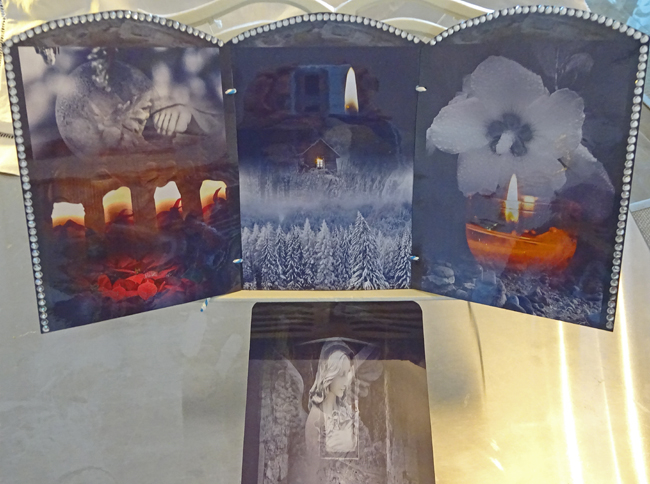
I. Ebaen. Advent Triptych. Christmas, 2017.
From Amirrorself.com: Making Art That Defines You: Happy Holidays! May You Have A Healthy, Safe, and Prosperous New Year!
